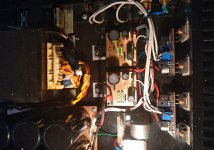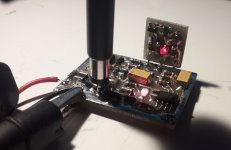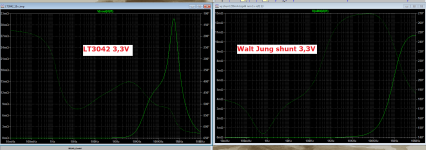if someone is rulling a GB at US cost, let me know before to trigger, I have an idea of a NLA part Rochester have too that could be (must be in fact) makes those I/V to climb a step, something more concrete than scopes capture that tells nothing after it is already good enough, as far music matters. GB from EU is too much expensive because Rohcester charges the VAT + the shipment + The VAT of the shipment. 2 ad1862 in 2016 costed me 120 euros iirc (back then to painkiller ad1862 dev pcb thread  )
)
Last edited:
I'll be using a (scrap) wooden wine bottle box 😁If you build the whole device in nice aluminium case, you realize, that DAC chip was not so expensive part even if you pay 60€ per piece
Congratulations on the shunt regulators. I think I know what the scheme is because I received it for review. But you are one of the few who got into it, I don't know what kind of results that reg has, but it is certainly better than most commercial regs.Don't get me wrong. My pcm63 dac is fully discrete shunt based regulated. It's a beefy mofo. But that thing costs a pretty penny. Not anyone can afford such a device, and i can tell you that it has diminishing returns to what it could cost for several percent lower performance. Heck, my tda1541a will cost a lot more, and new pcm63 board with fully discrete is on the way. Diy device costing several hundred bucks, that beats A LOT of commercial products costing many, many times as much is where the sweet spot is for most of the people.
You can see a part of the beefy supply. Not saying you are wrong, but saying you are not right either. Power supply is important (to me as much, if not more than anything else in chain), and if budget is a constraint, modern ultra low ldo are a really good solution (and those are hella not used frequently in commercial devices due to cost cutting, where you will see decades old stuff in top shelf stuff too).
View attachment 1327325
It bothered me that top performances were mentioned along with say 'cheap' regulators and power supplies. I know it's not like that because I've been making my own DACs for the last 15 years or so and I've learned all the power supply tricks very well. I'm not an electrical engineer, but I learned by trial and error. It wasn't a cheap way, but now I know what works and what doesn't. However, a Walt Jung or Salas shunt reg can be made very cheaply, so it's not a problem about money, but whoever wants can make more expensive versions like me, but I still think that $50 is not a lot for two regs with top performance.
And as for your shunt regs, I think they are grossly oversized, two PCM63 and op amps are not big consumers like my eight PCM1702, so the dissipation should not be higher than 4W max and that can be done very nicely in SMD technique, which is on the contrary and desirable because we work with HF noise in power supplies. Likewise, if I have to use 'cheap' regs, I would make sure that they have good characteristics in the MHz range, such as the ADP71.. series.
A new DAC is also on my mind, but I am still in doubt whether I will get the same result as with this one, and the financial expenditure will be much higher, just the op amps in the regulators would cost over $100, but what is more important, I would implement all the knowledge I have so far on just one PCB which would certainly help. Now, we can only find out if it makes sense if we try it
btw. I find this picture in my documents that show currents trough my shunts in my DAC
Attachments
Last edited:
I think there is no point in commenting on the rest except this one; my DAC was not made to be optimized for me or my hi-fi setup, that's the wrong way, it has to give a realistic sound image and not something we would like it to be.Don't get me wrong I am sure your DAC sounds great and are optmized to your whole hifi setup (as mines are).
cheers
Unfortunately, I don't have gerber files because I do all the PCBs myself at home, it's always a challenge for me. The picture shows the last one I made for the ceci est un Cube amplifier.I love following this exchange, trying to learn a thing here and there.
Are there available gerber files for SMD versions of these shunt regulators?
It seems because of the DIY community, I still have to do something in another software
Attachments
Diy device costing several hundred bucks, that beats A LOT of commercial products costing many, many times as much is where the sweet spot is for most of the people.
That "many, many times" sweet spot is imho, more often than not, pure fantasy, but it's the trip that matters, not the destination, right?
If i were you i would absolutely add a reclocker to that usb board. Good clocks made a good improvement upon the Mk2 board, but are an absolute must for the Mk3, where reclocking after the galvanic barrier is done not in physical flip flops but in FPGA.
I think there is no point in commenting on the rest except this one; my DAC was not made to be optimized for me or my hi-fi setup, that's the wrong way, it has to give a realistic sound image and not something we would like it to be.
The listening checking is always made at the end in a particular system. Here yours. At least if you listened to it. No matter what is saying the measurement and scopes that are good in many DACS. I think such a phrase has no sense, but marketing or self awards. Not a judgment. I am sure it sounds good but has drawbacks, first because the choice as an I/V W Jung himself alerted (better it is for a buffer) then because it is never something that has an no-end. I.e., you never know untill you found or heard better. I do not say to people not to try it, they should, Vunce told me he really like it in his system. And it is okay. Others than me told you already they do not think current opamp are the best choice in opamp categories for that I/V task. Hey I do not say it is bad and you will not hear me judging on sound description that has no sense because it is the room, the biased people, the rest of the system, etc. We are experienced enough to weigth the poors and cons when someone testimonies with his system full description (and even so we do not know, we are not in the room, etc)
And I never know a guy who can judge from a scope and measurements but to avoid the best worse designs I am sure your are not. (cause at least it passed the test of another guy here
And I think we all want a realistic image, etc. Mine has, your has, it is okay ! And do not play with the words, if you made it it pass your ears checking whatever it is for you or others. And so it pass in a known environment. If it is good here it can be good somewhere else... or maybe not. But having as many, several systems, each DAC, whatever being high level sounding have better marriage in a system than another. That's all I wanted to highligth behind the superlatives many like to congrat themselves and that eventually bias others untill they hear better . Simple two cents sociology and logic.
Have you seen superlatives from me when I described my design few pages ago (here just the layout, as I have the modesty no to comment on my personnal choices on the OPASs).), not really. It was a good enough, whatever I find it is really good...in my system. I want it to be clear (the meaning). I know two things too about the sense of the words Grunf and my ears are surely as old and experienced as yours
But all is okay, I just have an average seldom about readings too and always think I can help to decipher for less experienced than us. Also not everyone can test them all, so prudence is a good friend as well.
cheers
very french cubisme words than "Ceci est un cube" (amplifier). https://forums.melaudia.net/showthread.php?tid=7260
Last edited:
I believe that uBib is even better, but we still can't call it a real regulator, it lacks a feedback loop which limits it.
I fail to see how a high nfb regulator could be beneficial for powering digital circuits. Low noise is definitely important, but speed? Even the fastest feedback loop stands no chances when faced with MCK transitions.
The one thing i have learned about regulators is that no solution is universally good. In digital, physically large regulators appear to cause more problems than they solve. Those tiny, sub 1uV integrated regulators are just perfect.
@analog_sa , I compared the ADM7151 with the shunt reg, the PCBs were similar in size located right next to the load, the scope clearly shows that the shunt reduces the peaks and smooths them out in the MHz area. My friend did similar tests with the same results.
The biggest surprise for me were the shunt reg (pictured) for DIR9001, where I initially used two ADP7118 which were placed right next to the DIR itself, and they were worse than the shunt. Unfortunately, I only have basic instruments at home, so I did not go into further analysis, but if the simulator shows better results, why wouldn't it be the same in practice. I agree that each reg should be optimized for a certain load and that there is no universal solution, but I would always opt for a discrete reg that can be made in SMD technology today precisely because of HF noise.
The biggest surprise for me were the shunt reg (pictured) for DIR9001, where I initially used two ADP7118 which were placed right next to the DIR itself, and they were worse than the shunt. Unfortunately, I only have basic instruments at home, so I did not go into further analysis, but if the simulator shows better results, why wouldn't it be the same in practice. I agree that each reg should be optimized for a certain load and that there is no universal solution, but I would always opt for a discrete reg that can be made in SMD technology today precisely because of HF noise.
Attachments
- Home
- Source & Line
- Digital Line Level
- DAC AD1862: Almost THT, I2S input, NOS, R-2R



